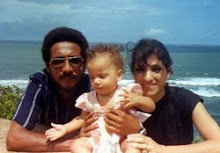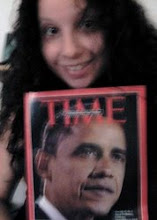Here's a little piece I wrote for an anthropology class called "Writing Culture," during the Spring 2008 semester.
*
Living Outside of the Boxes
On “Rethinking Race: Examining the Multiracial Experience”
A Guest Lecture and Discussion with Dr. Kelly Jackson
Sponsored by the University of Arizona Social Justice Leadership Center
4/24/2008
Growing up, when I was in middle school and high school we didn’t have the option of checking more than one box. And in that town and in that, you know, place where I grew up, if you were black you were black. You know, ‘one drop, you’re black.’ So, I identified as black. That’s how I identified, that’s what I checked on forms. Um, and that was who I was. And then in college, kind of understanding this idea of you can be alll different pieces of yourself, and not wanting to—reject that part of me that was my mom’s side, which was the white side, I identified as biracial. And that wasn’t really cool then.-Dr. Kelly Jackson
Dr. Kelly Jackson is a visiting speaker from the ASU School of Social Work. She stands in the center of the Kiva Room at the UA Student Union, slim and stylish in a red pencil skirt and pointed green flats. There is an air of friendly self-assurance about her, in the way she holds her shoulders straight back but doesn’t refrain from leaning into one hip at times, and in the readiness of her smile. She speaks in conversational, yet passionate tones—a vibrant young professional. Her hair falls just above her collarbone, in tight ringlets much like my own, except hers are a lighter brown. Her eyes might be blue or green or hazel, it’s hard to tell from where I’m sitting, two rows back in the center of the semicircular audience area. For her dissertation, she “asked multiracial people about their identity,” using the question “Who are you culturally?” Asking about culture, she felt, “encapsulates more” than focusing on categories like race, and allows for more “fluid” responses.
She begins her talk by going over five basic thematic areas that her respondents seemed to veer towards: “Transforming self,” being “ethnically ambiguous,” being “racially defiant,” “feeling like an outsider,” and “seeking community.” She discusses the way that people tend to want to “box” each other, and the often unpleasant What are you? question.
“As I’ve gotten older,” she says, “I joke that I’ve gotten whiter—looking. [Scattered laughs break out across the room] People, you know, they don’t understand, they’re like, ‘Oh, why are you interested in this topic?’ and I say ‘Well, I’m biracial,’ and they’re like ‘Really? I can’t believe it!’”
Heavy chuckling ensues. I identify with what she is saying. There are about twenty of us in the audience, maybe less, there appear to be a few more women than men. We seem like a relatively ethnically diverse group, more so than is often usual in a classroom at the U of A. As a person of biracial/ethnic/cultural heritage myself (my father is Somali and my mother is Armenian—according to the conventional US racial binary, he is black and she is white), I’m never quite comfortable with applying racial labels to other people.
So here, of all places, I prefer to refrain from “boxing” people into racial categories based on their physical features. I wait for people to speak for themselves. During the discussion session, audience members begin to self-identify: black/African American, white/Caucasian, black and white, Korean and white, Native American and black, white mother of biracial children, white and transgender/gender ambiguous, and more. At one point Dr. Jackson suggests that multiracial/ethnic/cultural people and people who identify as GLBTQ often seem to relate to each other, as somehow ‘falling outside of the boxes’ drawn by US society. Many of us start to nod our heads, perhaps sensing a commonality there—a “shared experience,” as one audience member will put it.
She recalls a college experience that many audience members seem to sympathize (and/or empathize) with:
I took this class I remember, with a prominent African American lecturer, and he was trying to make a point about race relations, and he said, "I want all my white students to go on this side of the room, and I want all my black students to go on this side." [...] I raised my hand and I said, “What if you’re both?” And he looked at me, with so much disdain, that I will never forget, he looked at me like I was, you know, pretty much an abomination, and said "Choose."
In the audience, some of us gasp, others shake their heads with mouths open, or lean back in their seats and sigh, eyebrows knotted. Audience members start talking about their own experiences. This pressure to “choose” one category to identify with seems to be a common, as does the urge to defy that pressure and define oneself on one’s own terms. Some people want all of the parts of their heritage to be recognized and feel left out when this doesn’t happen because of the way they look, some talk about fears regarding loss of identity for their children unless they marry someone of the/a minority part of their heritage, others argue that such fears are unfounded. Many people just keep echoing this sentiment: “I just want to be around people who get it.” And, Dr. Jackson asks, “Don’t we all just want that?”
“Even though race isn’t real, we experience race,” Dr Jackson says, and heads nod. That, she argues, is why the idea of “color-blindness” can be dangerous—when it’s used to deny the existence of racial inequality and injustice in our society.
Dr. Jackson reads a poem by a 14 year-old boy, including the line, “race is just a very small part of me,” and tears fill my own eyes. When I look around I see a few other people sniffling, too. Dr. Jackson’s voice breaks before she’s finished reading it.
“It gets blurry for me,” she says. “In a sense, guys, we’re all really multiracial.” Audience members talk excitedly about the idea of our generation becoming increasingly “mixed,” at the idea that we might be the “rainbow generation.” In a way, a sense of community seems to have been built right here in this room, over the course of this discussion. People respond to one another with encouraging tones, nodding heads, open eyes. In discussing a shared experience of alienation, a feeling of connection seems to have been reached.
But “Change will only happen if everyone gets onboard,” Dr. Jackson adds.
“So, you know, we all need to have this conversation, not just if you can identify with a minority culture.”
When it’s time to go, everyone in the room starts clapping.







0 comments:
Post a Comment